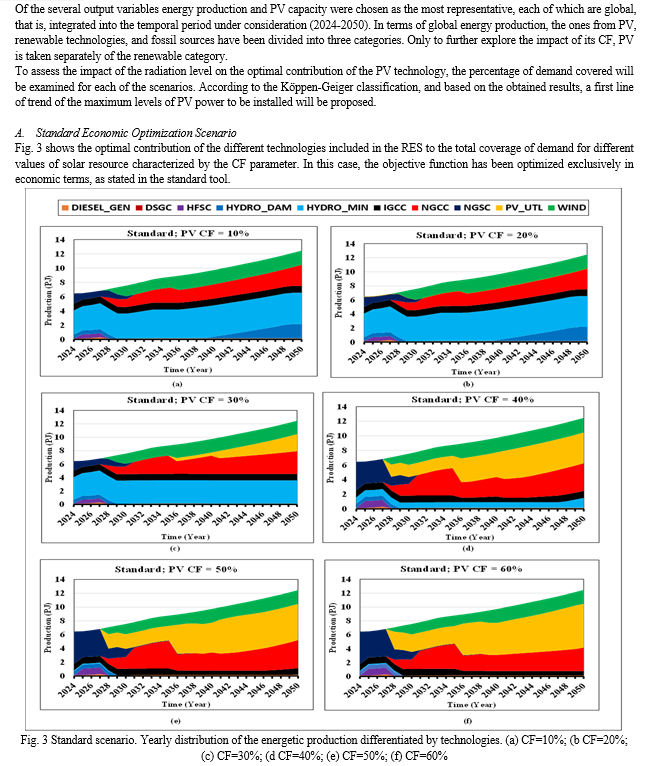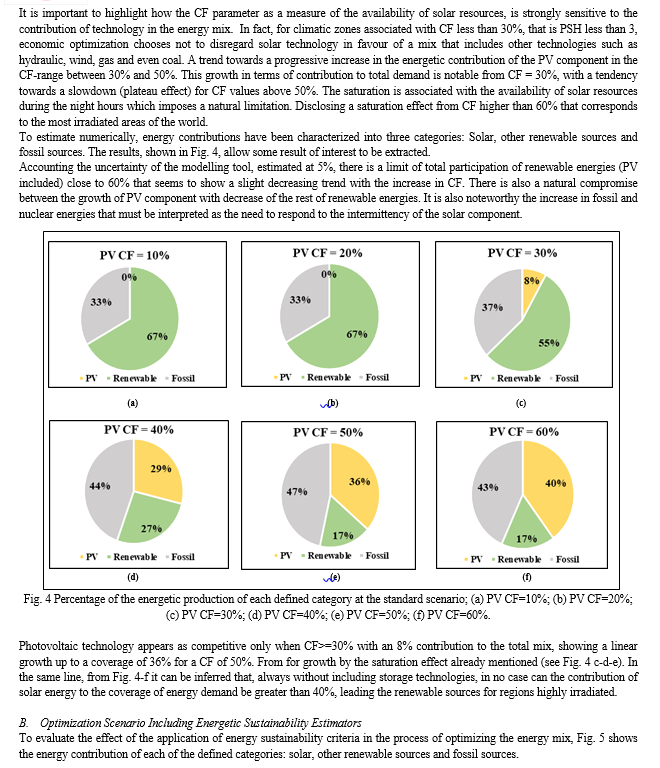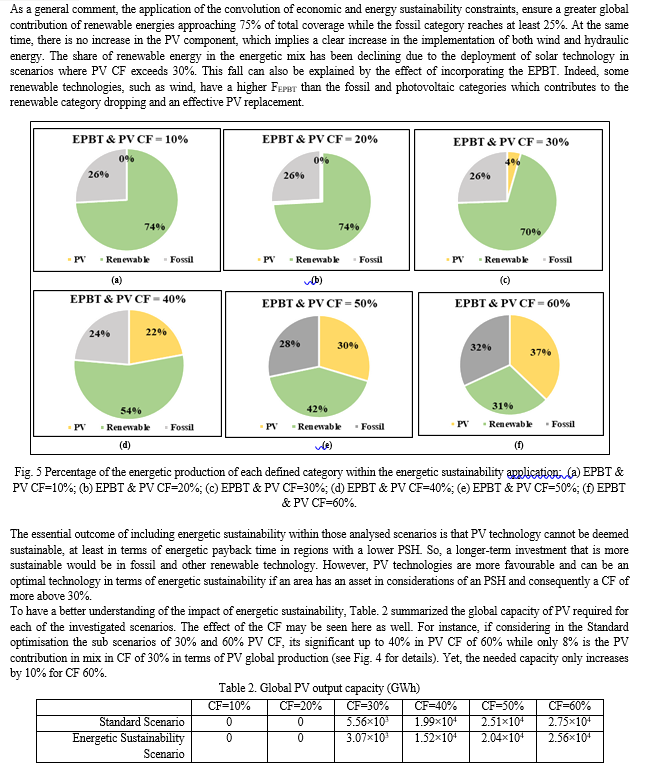Ijraset Journal For Research in Applied Science and Engineering Technology
- Home / Ijraset
- On This Page
- Abstract
- Introduction
- Conclusion
- References
- Copyright
Modelling of the Optimal Impact of Photovoltaic Technology on a Sustainable Energetic Mix as Function of the Climate Conditions
Authors: Mahamat Habib Bechir, A. Lopez- Aguera
DOI Link: https://doi.org/10.22214/ijraset.2023.56000
Certificate: View Certificate
Abstract
The current global trend towards decarbonized energy systems forces countries to encourage the inclusion of renewable energy. Among the main challenges, intermittent electricity production due to the fluctuation of the solar resource. In addition, the variability of costs associated with the availability of the local resource may limit its contribution toward the demand side. The trend of these possible medium-term limitations of PV energy production associated to the capacity of solar resources has been estimated. Across the OSeMOSYS open-source software tool, two optimizations have been modeled, one merely economic and the other including energy sustainability estimators. As main result, the medium-long term PV contribution appears as residual for cold and moderate climates with medial day-to-day irradiation of less than 3.2 Peak Solar Hours. In addition, a trend towards saturation 40% of the energy coverage for highly irradiated areas is observed. This effect, associated with the non-availability of resources at night, can be mitigated by incorporating accumulation technologies. The inclusion of energy sustainability criteria enhances previous considerations.
Introduction
I. INTRODUCTION
In light of the 2015 Paris Agreement on Climate Change, resilience has brought global consensus on the need to embrace new strategies for energy production, distribution, and usage [1]. Likewise, the transition from fuel-based power generation to carbon-neutrality is the great global challenge and represents a point of no further progress in the pursuit of a viable climate and stands out as the key pillar of the Sustainable Development Goals (SDGs) [2].
Renewable energy (RE) sources have emerged as the most appealing options for achieving power sector decarbonization since they are clean, secure, and considered sustainable [3]. Global policy processes and market frameworks are intended to ensure widespread adoption of RE in global and national energy systems.
Among the various issues associated to this energy transition, those arising from technological reliability and sustainability are especially essential, since they imply wide variety of production to satisfy the economy's energy demands. The fundamental global policy concerns in the post-2015 era has been led by the expansion of wind and solar power plants [4]. A relevant challenge of these of technologies is their significant resource fluctuations. The electricity generation of an intermittent generation source is generally substantially lower than its potential output or installed capacity exhibiting marked fluctuations over relatively short periods of time. In the case of solar power plants, these fluctuations are explained by cyclical and seasonal factors that can be predicted (e.g., hours of sunlight). An alternative to alleviate the unwanted effects of intermittency is to incorporate the use of storage technologies that allow to soften the effects of these.
Despite its intermittency, solar technology presents a promising forecast in the global market in terms of costs and scalability [5] being currently considered economically competitive with respect to other conventional sources. Solar energy production costs have fallen by 90% between 2009 and 2020, according to U.S. investment bank Lazard. In 2022, electricity from large solar plants cost a global average of just $0.037/kWh. By comparison, electricity generation costs from new coal plants were three times higher, at $0.112/kWh, while natural gas cost $0.059, nuclear $0.163 and wind $0.04/kWh. However, its competitiveness rate depends on the availability of local resources and other associated climatic factors. This means that the difference in cost per kWh produced varies up to 40% depending on the solar plant radiation levels [2].
The identification of the most appropriate technology is important for guaranteeing significant incorporation of intermittent renewable energy resources as function the local resource in the power mix [3]. That is, through medium and long-term energy system planning studies, optimal technologies and associated capacity needed for achieving policy priorities can be identified.
These kinds of assessment are undertaken over a long-time horizon and encompasses future demand expansion, technology, or policy agenda [3], [6]. Depending on some inputs (technical, economical, policy), they examine in each single stage with upgrades to existing capacity alongside the installation of new capacity, which may be in the form of generation units, electricity transmission and distribution lines, among others. Herefore, numerous flexible and open tools are now available to handle this kind of energy planning, each with a distinct methodology and numerical method, which is the case with Open-Source Energy Modeling System (OSeMOSYS). OSeMOSYS basis for economical optimization has been employed in a number of research, and a review of the literature revealed that authors such as [7]–[12] developed methodologies based on constraints, such as cost assessments, CO2 emissions activities, energy efficiency, and energy security, to mention few of. Indeed, economic optimization alone is insufficient for an adequate energy planning system. Other sustainability-related optimization criteria need to be introduced when analyzing different scenarios during the modeling of energy systems, and so far, few studies address this issue. As a matter of fact, the energetic sustainability indicators were integrated in OSeMOSYS as an extra cost [13]. This methodology employs the multicriteria approach by introducing the energy payback time (EPBT) the associated energetic sustainability indicator of several technology was used within an optimization of a set scenarios to evaluate the major effects. The well-known framework called Atlantis developed by M. Howells et al [14], is considered as case study. Although the Atlantis data is far from realistic, its use is interesting due to the various power generation technologies used in its modelling, including renewable and non-renewable.
The Capacity Factor (CF), which effectively examines how frequently a plant operates at full capacity, is one of the parameters utilized when energy modeling is occurred. This parameter is useful for expressing the radiation level of solar photovoltaic that varies between regions, for e.g., solar technologies have a Capacity Factor of zero at night, but during the day, it depends on the region irradiation level, thus the CF of a region with a long-time irradiance level will have a greater proportion of CF than a region with a shorter irradiation time.
Utilizing the methodology developed by [13], this paper assesses the effect of the solar resource on the desirable maximum limits in the percentage of contribution of solar energy to the electric energy vector. A set of scenarios is developed, in which in first the effect associated with the effect different PV CF is analysed, afterward scenario is built to evaluate the impact related to the energetic sustainability and then the resulting results are compared while accounting for the optimization estimators on economic parameters and introducing constraint. Although the current analysis is based on a fictional country, it has allowed us to confirm the strong dependence on cost-effectiveness of incorporating an intermittent energy source such as solar PV with the available resource as well as to assess the sustainability of energy mix planning.
II. METHODOLOGY
Developing a comprehensive energy transition pathway is a difficult endeavour which becomes even more complex when the incorporation sustainability criteria is envisaged. A wide variety of tools and approaches are accessible for this aim, such as OSEMOSYS, which enables informed decision-making by evaluating the medium-long term implications of pathway scenarios.
The ATLANTIS energetic mix instance of OSeMOSYS was employed in this paper to analyze how the implementation of sustainable development criteria affects the energetic mixing optimization. Aside from the energetic sustainability as an optimization constraint, the reliability of renewable technology, notably photovoltaic (PV), is also considered, and therefore a novel approach for estimating the solar Capacity Factor (CF) of any location on the globe is established.
Basically, Atlantis is a fictitious country featuring characteristics of both emerging and advanced countries that was created in MoMani, an OSeMOSYS interface, as an exercise for improvement and test control. The variables (technical and economic) used in Atlantis are not country specific and were derived from International Renewable Energy Agency papers and IEA-Energy Systems Analysis Program -Technology briefings (E01, E02, E03, E06, E10 and E11). Numerous scenarios associated to PV CF and energetic sustainability as an optimization constraint are thus developed and then analyzed from an economic and sustainability standpoint.
This section contains the energy modeling and optimization tool (OSeMOSYS). Similarly, the energetic sustainability indicator is discussed, followed by its introduction into OSeMOSYS as a constraint part of a sustainable optimization, and ultimately the PV CF estimation path is addressed.
A. OSeMOSYS Optimization Tool
Numerous models, mainly OSeMOSYS, have been developed to improve the design of energy supply networks by enhancing knowledge of the current and future interaction involving demand and supply, the environment, and the economy [11].
OSeMOSYS is referred to as a dynamic, bottom-up linear optimization model with a medium-to-long time horizon for integrated evaluation and energy planning [7], [15]. This energy design model tool quantifies the energy supply mix in terms of generation ability and supply, in addition to fulfilling demand for energy services throughout the year and at each stage of the case under investigation by optimizing the overall discounted costs on a global level [16], [17].
The merit variable to be optimized is the system total cost, which includes the initial investment, fixed costs, variable costs, and emission costs. The capital cost is the price for a new capacity expansion, while the fixed cost goes to maintaining the existing capacity. The variable cost is tied to each available capacity per technological unit [10].
Linear optimization is linked to diverse input variables that are related to technological constraints, economic realities, or environmental aims; as a result, it relies on a single decision-maker, flawless foresee, and competitive markets. The objective function constraint of demand coverage in OSeMOSYS is expressed by Equation (1).

Where:
y: Year in the time frame.
t: Correlate to each technology under evaluation.
TotCosty,t [$]: Global cost of the system along the time interval under study.
CapCosty,t [$]: The associated annual Capital cost.
FixCosty,t [$]: Yearly Fixed cost per technology.
VarCosty,t [$]: Annual Variable/Production cost per technology.
EmissCosty,t [$]: The associated penalties for emissions.
After its initial release in 2011, various editions of OSeMOSYS have been developed to improve realism modeling and simulation circumstances such as time and relaxing optimization. These versions also include energy-related coding blocks like storage, short-term flexibility, and interconnections, among other. Nowadays, several analytical interfaces are in use, with MoManI being utilized for this aim.
B. Energetic Sustainable Development Estimators
When analyzing the sustainability of an energy system, three pillars of sustainability indicators are presently available to easily analyze the long-term sustainability and environmental performance [18], [19]. These metrics include the Energy Payback Time (EPBT), the most reliable, unbiased estimators to assess the energetic sustainability of a product, method, or endeavour. Expressed in year, EPBT is defined as the time needed for an energy producing system to produce the same amount of energy as was consumed to produce the complete system [20].
In fact, the integration of the energetic sustainability into OSeMOSYS, will follow the rationale behind the study developed by [13] in which EPBT is integrated into the optimization process via a correction function, with the main challenge being to convert an energetic variable into an economic cost weight. The core principle is that the energetic system must generate additional energy each year in order to recover the energy used during the implementation phase (cradle-cradle). Considering the excess production dispersed evenly across the year, a correction factor FEPBT is defined for each technology as the ratio between the EPBT and the corresponding operational useful lifetime. The extra production will enhance the equivalent yearly Production Cost that is also the Variable Cost connected with the technology, while avoiding the deployment of extra energetic capacity. Equation (2) displays this additional variable, entitled Sustainable Production Cost.

In accordance with the flexibility of OSeMOSYS, the EPBT is incorporated in MoManI, where its variable is exactly converted into an economic cost weight using the production cost function. The main goal is to provide more credit to technology that recovers the energy used during the deployment process quickly (cradle-cradle).
C. Case Study: Atlantis Power System
Utilizing the Atlantis energetic framework instance from OSeMOSYS, this paper investigates how the adoption of energetic sustainability influences energetic optimization in the MoManI interface [14], which has been designed as a paradigm for software validation and control.

The Atlantis energy framework consists of five power plants, each of which uses a different imported fuel type. Among the installations are a large hydroelectric plant, a single cycle steam turbine that uses heavy fuel oil, a single cycle steam turbine that uses natural gas, a diesel-fed gas turbine, and a coal-based integrated gasification combine cycle plant. Over the course of the modeling period, this system is being expanded in order to assess the viability of incorporating new technologies such as wind turbines (25% load factor), mini hydro power plants (less than 1 MW), concentrated solar power (CSP), grid-connected PV systems (commercial), rooftop PV systems (in residential areas), a nuclear power plant (light water reactor), and new combined cycle power plants powered by natural gas.
The Reference Energy System (RES) is a conceptual representation of the real energy system that is being modeled, and it displays the flow of energy horizontally from resources on the far left to final energy usage on the far right [21]. Resources, primary, secondary, tertiary, and final demand, which is broken down into several demand sectors, are the five key energy levels in the Atlantis scenario.
Most of the Atlantis default data are used, as described in the Momani Training Manual [14]. In order to provide a more realistic appearance, certain of the initial parameters that had a less than ideal configuration were reviewed. In fact, the current Atlantis parameters were developed using technical and economic inputs from the previous decade; however, in light of recent advancements and the quick adoption of renewable and even non-renewable technologies, some important parameters, such as the variables cost and emissions per unit of energy, have been updated.
Among the changed settings was the restriction of the large hydroelectric plant's maximum annual output to 2 PJ rather than the default unrestricted output. Additionally, because CSP, and PV roof technologies were disabled during the initial Atlantis modeling, these technologies are not covered in this paper.
Additionally, nuclear technology has consistently been at the centre of social debate and is hence seen as a non-proliferation technology, therefore, it is hard to measure its EPBT properly. While nuclear fuel efficiency is high, the EPBT only lasts around three years in terms of production. However, considering the implementation of the power plant and waste management, the most recent estimates show a realistic EPBT between 80 and 300 years. Which is why, nuclear energy production is not considered in our analysis.
The updated parameters can be used to examine the implications of energy sustainability, however they're not ideal until the instance being studied is unique to a real country. Table 1 provides a detailed description of all the incorporated revised parameter data for the Atlantis energy Modeling system.






Finally, in the most irradiated areas of the planet ( SPH>5), photovoltaic technology can lead the energy mix with 40% of the total coverage of demand. This limit, induced by the intermittency of production, can be broken with the incorporation of adequate storage systems.
Conclusion
Attending the post-2015 era energetic global policy is leaded by the expansion of wind and solar power plants, the main challenge to face is their significant resource fluctuations. Despite its intermittency, solar technology presents a promising forecast in the global market in terms of costs and scalability being currently considered economically competitive with respect to other conventional sources. However, its competitiveness rate depends on the availability of local resources and other associated climatic factors incorporating a new uncertainty because difference in cost per kWh produced varies up to 40% depending on the solar plant radiation levels. To evaluate the impact of PV on a sustainable energetic mix as function of the climatic conditions through medium and long-term energy system planning an energy modelling, based on the Open-Source OSeMOSYS optimization tool has been designed and evaluated. As case of study, the Atlantis fictitious country has been considered. Although the Atlantis data is far from realistic, its use is interesting due to the various power generation technologies used in its modelling, including renewable and non-renewable. The Capacity Factor (CF), which effectively examines the operative efficiency of a solar plant, directly related with the local radiation level has been used as variable of merit. Appling the proposed methodology, the effect of the solar resource on the desirable maximum limits in the percentage of contribution of solar energy to the electric energy vector is assessed. A set of scenarios is developed, in which in first the effect associated with the effect different PV CF is analysed, afterward scenario is built to evaluate the impact related to the energetic sustainability and then the resulting results are compared while accounting for the optimization estimators on economic parameters and introducing constraint. As main results, the pure economic optimization shows how climatic zones associated with CF less than 30%, the economic optimization chooses not to disregard solar technology in favour of a mix that includes other technologies such as hydraulic, wind, gas and even coal. A trend towards a progressive increase in the energetic contribution of the PV component in the CF-range between 30% and 50%, This growth in terms of contribution to total demand is notable from CF = 30%, with a tendency towards a slowdown (plateau effect) for Cf values above 50%. The saturation is associated with the availability of solar resources during the night hours which imposes a natural limitation. disclosing a saturation effect from CF higher than 60% that corresponds to the most irradiated areas of the world. Similar results are obtained when sustainability-related criteria are included into the optimization process, being the most interesting difference, a greater global contribution of renewable energies approaching 75% of total coverage while the fossil category reaches at least 25%. At the same time, there is no increase in the PV component, which implies a clear increase in the implementation of both wind and hydraulic energy. The share of renewable energy in the energetic mix has been declining due to the deployment of solar technology in scenarios where PV CF exceeds 30%. Finally, based on the linear correlation between CF and mean daily irradiation level (PSH), the results acquired and based on the Köppen-Geiger climate classification, has been transferred to a first rude guide word map. This tool allows a first classification of suitability of the PV technology divided into five categories attending the limits of maximum desirable solar contribution in the total energy mix. The competitiveness of photovoltaics is hardly inhibited both in economic and sustainability terms for areas weakly irradiated (SPH<3). In these areas, which normally presents a high seasonality, the contribution of technology should be considered residual although surely interesting for residential purpose. Finally, in the most irradiated areas of the planet ( SPH>5), photovoltaic technology can lead the energy mix with 40% of the total coverage of demand. This limit, induced by the intermittency of production, can be broken with the incorporation of adequate storage systems. Although the current analysis is based on a fictional country, it has allowed us to confirm the strong dependence on cost-effectiveness of incorporating an intermittent energy source such as solar PV with the available resource as well as to assess the sustainability of energy mix planning.
References
[1] H. Desing and R. Widmer, reducing climate risks with fast and complete energy transitions: Applying the precautionary principle to the Paris agreement, Environmental Research Letters. IOP Publishing Ltd 2021; 16: 12 [2] R. Baron, Energy Transition after the Paris Agreement: Policy and Corporate Challenges. In: Background paper for the 34th Round Table on Sustainable Development Wind Europe Summit, 28-29 September 2016: Hamburg Environmental Research Letters, pp 01-16. [3] P. Das, J. Mathur, R. Bhakar, and A. Kanudia, Implications of short-term renewable energy resource intermittency in long-term power system planning, Energy Strategy Reviews 2018; vol. 22, pp 1–15. [4] J. Yin, A. Molini, and A. Porporato, Impacts of solar intermittency on future photovoltaic reliability, Nat Commun 2020; 11: 1. [5] Z. Abdmouleh, R. A. M. Alammari, and A. Gastli, Review of policies encouraging renewable energy integration & best practices, Renewable and Sustainable Energy Reviews, Elsevier Ltd 2016; vol. 45, pp 249–262, [6] A. Younis, R. Benders, J. Ramírez, M. de Wolf, and A. Faaij, Scrutinizing the Intermittency of Renewable Energy in a Long-Term Planning Model via Combining Direct Integration and Soft-Linking Methods for Colombia’s Power System, Energies (Basel) 2022; 15:20 [7] A. Dhakouani, E. Znouda, and C. Bouden, Impacts of energy efficiency policies on the integration of renewable energy, Energy Policy 2019; 133: 110922. [8] G. Godínez-Zamora et al., Decarbonising the transport and energy sectors: Technical feasibility and socioeconomic impacts in Costa Rica, Energy Strategy Reviews 2020; 32. [9] J. Augutis, L. Martišauskas, and R. Krikštolaitis, Energy mix optimization from an energy security perspective, Energy Convers Manag 2015; vol. 90, pp 300–314. [10] G. N. P. de Moura, L. F. L. Legey, and M. Howells, A Brazilian perspective of power systems integration using OSeMOSYS SAMBA – South America Model Base – and the bargaining power of neighbouring countries: A cooperative games approach, Energy Policy 2016; vol. 115, pp 470–485. [11] M. G. Prina, D. Groppi, B. Nastasi, and D. A. Garcia, Bottom-up energy system models applied to sustainable islands, Renewable and Sustainable Energy Reviews 2021; 152 [12] B. D. Leibowicz, C. M. Lanham, M. T. Brozynski, J. R. Vázquez-Canteli, N. C. Castejón, and Z. Nagy, Optimal decarbonization pathways for urban residential building energy services, Appl Energy 2018; vol. 230, pp 1311–1325. [13] B. Mahamat Habib, D. Ferreira Martínez, and A. López Agüera Energetic Sustainable Transition Process Optimization in Terms of LCA Using CLEWs Tools, ICoWEFS 2022, Proceedings of the 2nd International Conference on Water Energy Food and Sustainability (ICoWEFS 2022), pp. 147–157, 2023. [14] Y. Almulla, O. Broad, A. F. Shivakumar, E. Ramos, G. Avgerinopoulos, and M. Howells, Model Management Infrastructure (MoManI) Training Manual, KTH-dESA 2017, pp. 1–61. [15] M. Welsch, M. Howells, M. Bazilian, J. F. DeCarolis, S. Hermann, and H. H. Rogner, Modelling elements of Smart Grids - Enhancing the OSeMOSYS (Open Source Energy Modelling System) code, Energy 2012; Vol. 46, pp. 337–350. [16] 2023, Introduction to OSeMOSYS — OSeMOSYS 0.0.1 documentation.[online] Available: https://osemosys.readthedocs.io/en/latest/manual/Introduction.html [17] M. Howells et al., OSeMOSYS: The Open-Source Energy Modeling System. An introduction to its ethos, structure, and development., Energy Policy 2011; Vol. 39, pp 5850–5870. [18] J. Ling-Chin, O. Heidrich, and A. P. Roskilly, Life cycle assessment (LCA) - From analysing methodology development to introducing an LCA framework for marine photovoltaic (PV) systems, Renewable and Sustainable Energy Reviews 2016; vol.59, pp 352–378. [19] M. Z. Hauschild, R. K. Rosenbaum, and S. I. Olsen, Life Cycle Assessment: Theory and Practice,Life Cycle Assessment: Theory and Practice 2017; pp. 1–1216. [20] C. Cabo Landeira, PV systems design optimization as function of the climatic conditions. PhD Thesis, Santiago de Compostela University, Santiago de Compostela, 2018. [21] K. Amirnekooei, M. M. Ardehali, and A. Sadri, Integrated resource planning for Iran: Development of reference energy system, forecast, and long-term energy-environment plan, Energy 2012; vol. 46, pp. 374–385. [22] A. B. López, C. Cabo Landeira, A. López Agüera Optimal PV Technology Selection Depending on Climatic Conditions, IntJRes Appl Sci Eng Technol 2017; Vol. 5, pp 2962–2970.
Copyright
Copyright © 2023 Mahamat Habib Bechir, A. Lopez- Aguera . This is an open access article distributed under the Creative Commons Attribution License, which permits unrestricted use, distribution, and reproduction in any medium, provided the original work is properly cited.

Download Paper
Paper Id : IJRASET56000
Publish Date : 2023-10-04
ISSN : 2321-9653
Publisher Name : IJRASET
DOI Link : Click Here
 Submit Paper Online
Submit Paper Online

